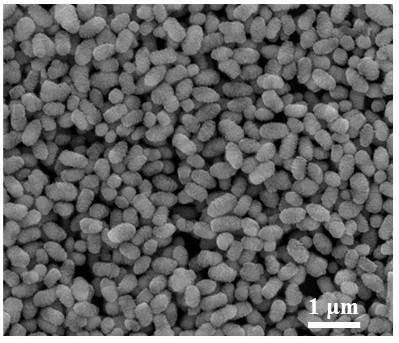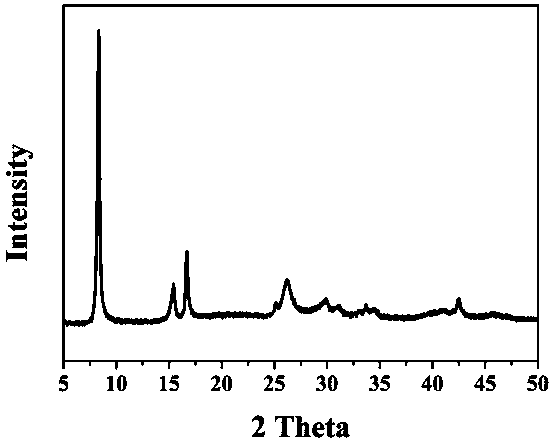Copper-terephthalic acid nano particle, and preparation method and applications thereof
A technology of terephthalic acid and nanoparticles, applied in the field of nano-medical device development, can solve the problems of low accuracy, fluorescence quenching, misdiagnosis, etc., and achieve the effect of accurate labeling
- Summary
- Abstract
- Description
- Claims
- Application Information
AI Technical Summary
Problems solved by technology
Method used
Image
Examples
Embodiment 1
[0035] A preparation method of copper-terephthalic acid nanoparticles, the specific process is as follows:
[0036] To prepare uniform copper-terephthalic acid nanoparticles, take 0.05 mmol copper acetate (Cu(CH 3 COO) 2 ) (0.009083g) was dispersed in 20 mL of 0.08% by mass soluble starch (Sinopharm Chemical Reagent Co., Ltd.) aqueous solution, and terephthalic acid (C 8 h 6 o 4 ) (0.005815 g, 0.035 mmol) and sodium hydroxide (NaOH) (0.0028 g, 0.07 mmol) were dispersed in 10 mL of distilled water, and then the solution was added dropwise to the above mixed solution of copper acetate and starch, and stirred for 10 min. Then the solution was left to stand for 24 h, and finally centrifuged and washed to obtain the product.
[0037] The scanning electron microscope images of the above products are as follows: figure 2 shown by figure 2 It can be seen that the product has good dispersion, and the shape of a single particle is similar to a pinecone, with a long axis of about...
Embodiment 2
[0039] Detection of Decomposition Ability of Copper-terephthalic Acid Nanoparticles in Acidic Environment
[0040] Disperse the sample prepared as described in Example 1 in the acetic acid-sodium acetate buffer solution with pH 7 and 4 (the concentration of the sample in the buffer is 12.5 μg / mL), and stir at 37 °C for 4 h , after the product was centrifuged, the supernatant was taken, detected by UV-Vis, and the Cu in the solution was qualitatively determined according to the intensity of the absorption peak at 750 nm. 2+ Content changes, see the results for details Figure 4 .
[0041] Depend on Figure 4 It can be seen that under acidic conditions, copper-terephthalic acid nanoparticles in the supernatant obviously belong to Cu 2+ Absorption peak, while there is no obvious Cu in the supernatant under neutral conditions 2+ The absorption peak of , indicating that the nanoparticles are unstable under acidic conditions, easy to decompose and release Cu 2+ , and is stable ...
Embodiment 3
[0043] Zeta potential detection of copper-terephthalic acid nanoparticles in different pH environments
[0044] The sample prepared as described in Example 1 was dispersed in the acetic acid-sodium acetate buffer solution with a pH of 7 and 4 (the concentration of the sample in the buffer was 12.5 μg / mL), and the concentration of the nanoparticles was detected by a Zata potentiometer. Zeta potential under different pH conditions, the results are detailed in Figure 5 .
[0045] Depend on Figure 5 It can be seen that the Zeta potential of nanoparticles is relatively stable and does not change with the pH of the environment.
PUM
| Property | Measurement | Unit |
|---|---|---|
| length | aaaaa | aaaaa |
| length | aaaaa | aaaaa |
Abstract
Description
Claims
Application Information
 Login to View More
Login to View More - R&D
- Intellectual Property
- Life Sciences
- Materials
- Tech Scout
- Unparalleled Data Quality
- Higher Quality Content
- 60% Fewer Hallucinations
Browse by: Latest US Patents, China's latest patents, Technical Efficacy Thesaurus, Application Domain, Technology Topic, Popular Technical Reports.
© 2025 PatSnap. All rights reserved.Legal|Privacy policy|Modern Slavery Act Transparency Statement|Sitemap|About US| Contact US: help@patsnap.com



